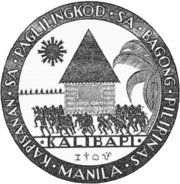KALIBAPI
|
Kapisanan ng Paglilingkod sa Bagong Pilipinas (KALIBAPI)
ᜃᜎᜒᜊᜉᜒ |
|
|---|---|
 |
|
| Leader | Directors-General: Benigno S. Aquino (1942-1943) Camilo Osías (1943-1945) |
| Secretary-General | Pio Duran |
| Founder | Philippine Executive Commission |
| Founded | December 8, 1942 |
| Dissolved | 1945 |
| Headquarters | Manila, Second Philippine Republic |
| Ideology |
Filipino nationalism Fascism Pro-Japan |
| Political position | Far-right |
| Party flag | |
 |
|
The Kapisanan ng Paglilingkod sa Bagong Pilipinas (lit. Association for Service to the New Philippines), or KALIBAPI (Baybayin:ᜃᜎᜒᜊᜉᜒ), was a Filipino political party that served as the sole party of state during the Japanese occupation. It was intended to be a Filipino version of Japan's governing Taisei Yokusankai party.
Formed by the Philippine Executive Commission (Komisyong Tagapagpaganap ng Pilipinas) under the leadership of Jorge Vargas, the party was created by Proclamation No. 109 of the PEC, a piece of legislation passed on December 8, 1942 banning all existing political parties and creating the new governing alliance. The Japanese had already dissolved all political parties on the islands, including even the pro-Japanese Ganap Party, and established KALIBAPI as a mass movement designed to support the occupation whilst taking advantage of nationalism in the region. Established in December 1942, the party was headed by its Director-General Benigno S. Aquino with Pio Duran as Secretary-General and effective second in command and Ganap leader Benigno Ramos as a member of the executive committee. The three toured the Philippines, setting up local party organisations and promoting the "new order in East Asia" at mass meetings.
For the Japanese, KALIBAPI served as a labour recruitment service in its initial stages before taking on an expanded role in mid 1943. It was left to KALIBAPI to write the new constitution and establish the new National Assembly, resulting in Aquino's appointment as Speaker (as his replacement as Director-General by Camilo Osías). All 54 members of the Assembly were KALIBAPI members, although 33 of them had held elected office before the invasion as well. KALIBAPI soon claimed a membership that ran into the hundreds of thousands. The islands were declared officially independent as the Second Philippine Republic on 14 October 1943 under the Presidency of José P. Laurel and his KALIBAPI government. This had been accomplished through the Preparatory Committee for Philippine Independence, which KALIBAPI had established in mid-1943 under Japanese direction.
...
Wikipedia
